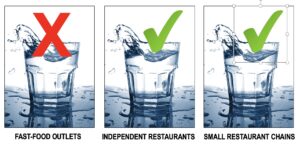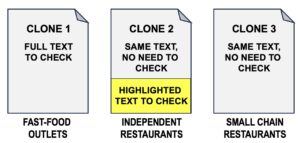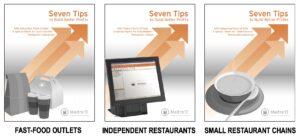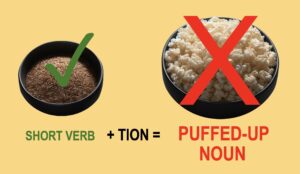
How to clone a white paper for multiple audiences [with example]
Most white paper readers want content directed right to them.
6-minute read.
Fair enough. Don’t you?
But what if you have two or three different audiences, in different roles or sectors? How can you engage them all?
Sure, you can always write a separate white paper for each audience.
But what if your client or company can’t afford that?
Why not “clone” one basic white paper?
This means creating a slightly different version of the same master document for each different audience.
This strategy can be a win-win-win for everyone.
For a white paper reader, cloning creates content aimed right at them.
For a white paper writer, cloning gives you a competitive advantage over other writers who don’t know how to do this.
You can supply two or more white papers for only a little more work, and a slightly higher fee.
For a white paper sponsor, cloning generates better-targeted content for less time and money than doing multiple standalone papers.
So cloning a white paper can make everybody happy: reader, writer, and sponsor.
And it’s not hard to do, if you plan it from the start. Here’s how.

The steps to cloning a white paper
Cloning an organism in a lab requires many steps with fancy equipment.
Cloning a white paper also takes a few steps. But it doesn’t require any special software; you can do it with Word or GDoc.
Here are those steps in brief:
- Develop an idea that works for every segment of your audience
- Research the idea for every audience
- Write one master white paper with alternate phrases
- Save a copy of the paper for each audience
- Make your cloned papers easy to review
- Tweak the titles to engage each audience
- Make a different cover for each version
- Promote to each audience
That sounds like a lot of steps, doesn’t it?
But every time I do it, it’s easier than you might expect.
Here’s an example that I actually did, to show you every step in more detail.
An actual example of cloning in action
I once prepared a set of white papers for a point-of-sale software maker.
This company has three audiences:
- Fast-food outlets
- Independent, sit-down restaurants
- Small restaurant chains with a management team
Each audience had a slightly different size and scope. But they weren’t so different that the client could justify doing three separate white papers.
That’s why I suggested we create one white paper and then clone it to generate a slightly different version for each audience.
Step 1: Develop an idea that works for every segment
You obviously want to cover pretty much the same topic in each clone. So develop an idea that works for every segment.
For example, my client and I came up with this title:
Seven Tips to Build Better Profits with Today’s Integrated Point-of-Sale
Since most restaurants struggle to be profitable, this headline appeals to everyone in that space. So far so good.
Step 2. Research the idea for each audience
We brainstormed, I did some further research, and we ended up with seven concrete suggestions that fit this topic.
The only problem: Six out of seven suggestions applied to all three audience segments. But one didn’t.

A typical bar in a restaurant suffers 25% loss through over-pours, giveaways, and theft. So the two papers for table-service restaurants could cover how to control costs on alcohol.
But fast-food outlets don’t pour booze and don’t have those losses.
For those readers, I researched something more relevant to them: ordering screens for the cooks. These screens show numerous orders at a time, faster and more reliably than using paper slips.
So the cook can add ketchup to three burgers in one go and save a few seconds.
That became tip #7 for the fast-food version of the white paper.
Step 3. Write one master white paper with alternate phrases
Now draft your white paper, remembering each audience as you write.
But don’t try to juggle a set of different documents. That will only waste your time and threaten your sanity.
To stay efficient, work in one master file.
If you have alternate tips, write them all in the same master file.
So what if you end up with two tip #7s like I did? That’s a lot easier than having two or three different files to manage.
Hint: The key is to try to constrain any differences to as few places as possible. Then highlight any differences in yellow to spot them quickly in any pass.
One good example is when one audience has slightly different jargon, when they call people or things by different names.
This could come up in many ways:
- Audience Role A / Role B
- Product A / Product B
- Region 1 / Region 2
- Vertical Market A / Vertical Market B
Ideally, you can get around these differences by creating a set of alternate phrases that work in any version.
For example, in my three clones, two segments had managers. But the independents were generally family-owned.
So I wrote “You should” for the family-owned independents, and “Your managers should” for the chains.
I just typed in both versions of that text: “You/your managers should”.
Beyond that, 85% of the text was the same in all three versions. This deliberate approach made all my further steps faster and easier.
Step 4. Save a copy of the white paper for each audience
When you have a draft ready to review, save several copies of your master document—one for each clone—each with a different filename.
Then you can scan through and remove the bits of text that don’t apply to that version.
This is far simpler than trying to manage multiple versions with niggling little differences.
For example, for my two tip #7s, I deleted the irrelevant tip from each clone.
Then I made a quick pass through the text, scanning for yellow highlights.
When I spotted one, I deleted part of the constructions like “You should/Your manager should” and left in the other, as shown in the table.
| Version | Audience | Differences |
|---|---|---|
| 1 | Fast-food outlets | Your manager should |
| 2 | Independents | You should |
| 3 | Small chains | Your manager should |
| 1 | Fast-food outlets | Tip on ordering screens for cooks |
| 2 | Independents | Tip on reducing losses from bar |
| 3 | Small chains | Tip on reducing losses from bar |
Step 5. Make your “clones” easy to review
With publishing software like Adobe FrameMaker, you can set up “conditional text” and turn it on or off to generate different versions of a document.
This is great for a 300-page technical manual.
But it’s overkill for a 10-page white paper. You want to set up a review process that’s quick and easy for everyone.

Don’t make your reviewers read through every clone looking for the subtle differences. Highlight any difference so reviewers can quickly scan to find them.
For this set of three clones, I sent my client three separate documents in Word, with any alternate text highlighted in yellow.
All the reviewers marked up one version and then checked for yellow highlights in the two other clones.
That was simple and idiot-proof, for all of us.
Step 5. Tweak the titles to engage each audience
You certainly want to give each clone a different name.
We explicitly named each audience with a different subtitle in the format “a special report for [audience].”
In full, those three titles were:
- A special report for quick-service restaurant executives
- A special report for independent restaurant owners
- A special report for table-service restaurant executives
Step 6. Make a different cover for each version
This is for the convenience of the publisher, to make it easier to tell apart the different versions at a glance.
My client used a different graphic for each audience, as shown above.
For even more contrast, I suggested using a different color for each cover.
That way a sales or marketing person could quickly grab “the orange one” for the fast-food audience.
But my client wanted to use the same corporate colors on each cover. So be it.
Step 7. Promote to each audience
The whole point of having multiple white papers is to reach multiple audiences.
So don’t line up all three on the same web page.
Create a separate landing page for each audience and promote each clone to its own audience.
This is what my client did, and they reported that those white papers worked well for each audience.
A win-win-win for everyone
When you encounter a client with several audiences but not enough budget to create a unique white paper for each segment, try proposing this approach.
Most clients will jump at this chance to reach all their audiences, especially when I say I’m not going to charge then 2X or 3X the cost.
I price three cloned versions at perhaps 25% more than doing a single white paper.
This benefits everyone. Readers get content aimed specifically at them.
As the writer, I deliver 2X or 3X the value for just a little extra effort.
And my client gets two or three papers for only a little higher fee than just one.
So everybody’s happy. Try it, and let me know how it works for you.
Originally published 13 June 2014. Last updated 19 February 2024.
Want more useful tips like this? Get my free newsletter White Paper World.






[…] In a previous article, I described how to “clone” one basic document for various segments of an audience. […]